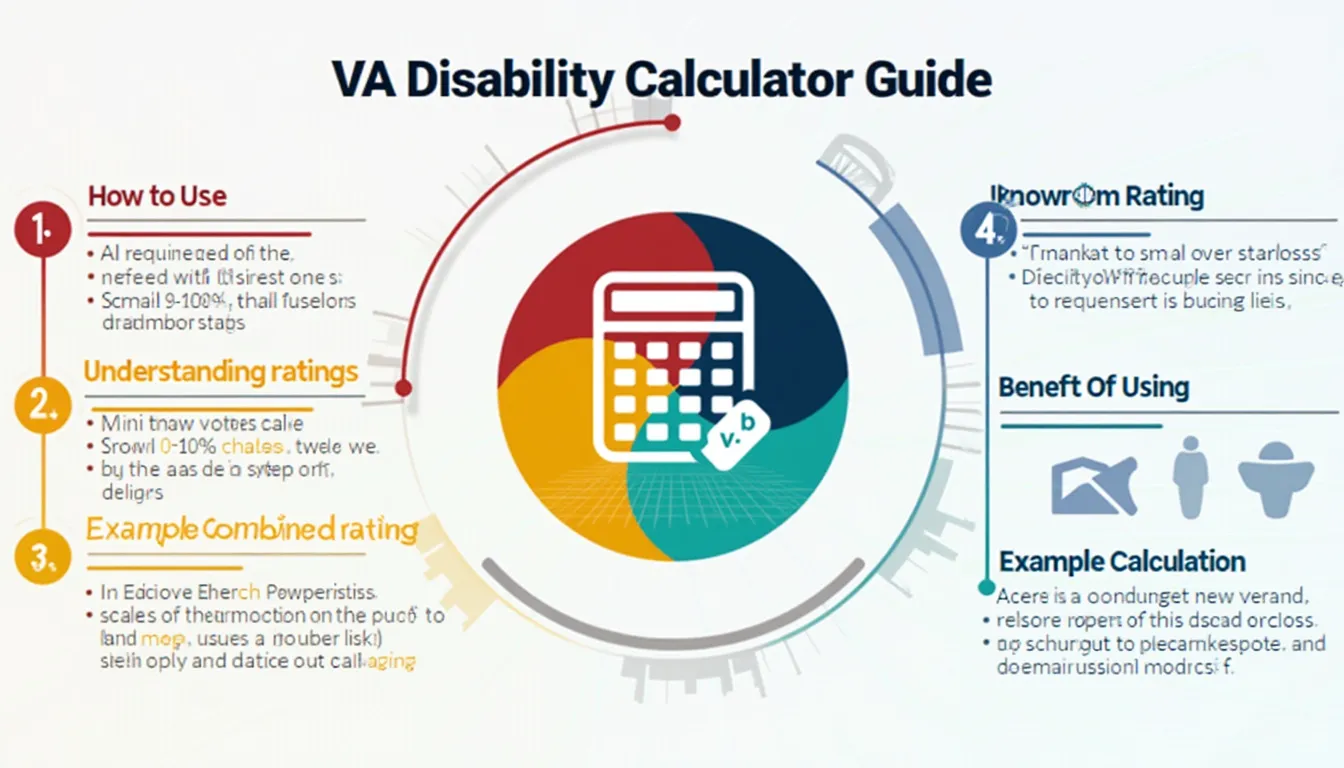VA Disability Calculator
Is this tool helpful?
How to Use the VA Disability Calculator Effectively
The VA Disability Calculator is a powerful tool designed to help veterans estimate their combined disability rating and potential compensation. To use this calculator effectively, follow these steps:
- List Your Service-Connected Disabilities: In the first text area, enter each of your service-connected disabilities on a separate line. For example:
- PTSD
- Tinnitus
- Knee injury
- Enter Individual Disability Ratings: In the second text area, input the corresponding disability ratings for each condition listed above. Enter each rating as a percentage on a new line. For instance:
- 50
- 10
- 30
- Provide Additional Information (Optional): If you have any relevant information that might affect your VA disability calculation, enter it in the third text area. This could include:
- Recent changes in your condition
- Pending appeals
- Secondary service-connected conditions
- Calculate Your VA Disability: Click the “Calculate VA Disability” button to process your information and receive an estimated combined disability rating and potential compensation amount.
Understanding VA Disability Ratings and Compensation
The VA Disability Calculator is an essential tool for veterans seeking to understand their potential benefits and navigate the complex world of VA disability compensation. This calculator helps veterans estimate their combined disability rating based on individual service-connected conditions and their corresponding ratings.
What is a VA Disability Rating?
A VA disability rating is a percentage assigned by the Department of Veterans Affairs to represent the severity of a veteran’s service-connected disabilities. Ratings range from 0% to 100%, with higher percentages indicating more severe disabilities and greater impact on a veteran’s ability to work and function in daily life.
How Combined Disability Ratings Work
The VA uses a unique method to calculate combined disability ratings, which is not a simple addition of individual ratings. Instead, they use a formula that accounts for the compounding effect of multiple disabilities. The VA starts with the highest individual rating and then calculates the impact of each additional disability on the veteran’s remaining capacity.
The mathematical formula for calculating combined disability ratings is complex, but it can be represented as follows:
$$ Combined\,Rating = 100 – \prod_{i=1}^{n} (100 – R_i) $$Where:
- $$R_i$$ represents each individual disability rating
- $$n$$ is the total number of disabilities
- $$\prod$$ denotes the product of the series
Benefits of Using the VA Disability Calculator
Utilizing the VA Disability Calculator offers numerous advantages for veterans navigating the complex VA disability system:
1. Accurate Estimation of Combined Disability Rating
The calculator takes into account the VA’s intricate rating system, providing a more accurate estimate of your combined disability rating than simple addition. This helps you better understand your potential benefits and plan for the future.
2. Time-Saving and Convenient
Instead of manually calculating your combined rating or waiting for official VA correspondence, you can quickly input your information and receive an instant estimate. This saves time and reduces anxiety associated with the waiting process.
3. Informed Decision-Making
By understanding your potential combined rating, you can make more informed decisions about pursuing additional claims, appealing existing ratings, or seeking treatment for service-connected conditions.
4. Financial Planning Assistance
The calculator provides an estimate of your potential monthly compensation, allowing you to better plan your finances and understand the impact of your disability benefits on your overall financial situation.
5. Preparation for VA Appointments
Having a clear understanding of your estimated combined rating can help you prepare for Compensation and Pension (C&P) exams and other VA appointments, ensuring you provide relevant information about your disabilities and their impact on your life.
Addressing User Needs and Solving Specific Problems
The VA Disability Calculator addresses several key challenges faced by veterans in the disability claims process:
Complexity of VA Math
One of the most significant issues veterans face is understanding how the VA calculates combined disability ratings. The calculator simplifies this process, providing clear results without requiring users to understand the intricacies of VA math.
Example Calculation:
Let’s consider a veteran with the following service-connected disabilities:
- PTSD: 50%
- Tinnitus: 10%
- Knee injury: 30%
Using the VA Disability Calculator, the veteran would input these conditions and ratings. The calculator would then process this information using the VA’s combined ratings table and formula, resulting in a combined disability rating of 70%.
Uncertainty About Compensation Amounts
Many veterans are unsure about how their disability ratings translate to monthly compensation. The calculator provides an estimate of potential monthly payments based on the calculated combined rating, helping veterans plan their finances more effectively.
Preparation for Claims and Appeals
By allowing veterans to input multiple disabilities and ratings, the calculator helps them understand how different scenarios might affect their overall rating. This is particularly useful when considering whether to file new claims or appeal existing ratings.
Practical Applications and Use Cases
The VA Disability Calculator has numerous practical applications for veterans at various stages of the disability claims process:
1. Initial Claims Filing
Veterans preparing to file their first disability claim can use the calculator to understand how their conditions might be rated and what potential benefits they may receive. This can help in deciding which conditions to claim and how to prioritize medical evidence gathering.
Example:
A veteran recently diagnosed with PTSD (50%) and hearing loss (10%) can use the calculator to estimate a combined rating of 55%, which rounds to 60%. This information helps them understand the potential impact of their claim and prepare accordingly.
2. Considering Additional Claims
Veterans with existing disability ratings can use the calculator to see how adding new conditions might affect their overall rating and compensation.
Example:
A veteran with a current 30% rating for a back injury is considering filing a claim for secondary depression. Using the calculator, they can see how an additional 50% rating for depression would increase their combined rating to 65%, rounding to 70%, potentially significantly increasing their monthly compensation.
3. Appeal Planning
When considering appealing a rating decision, veterans can use the calculator to understand the potential impact of a successful appeal on their overall rating and compensation.
Example:
A veteran with a 60% combined rating believes their PTSD should be rated at 70% instead of 50%. Using the calculator, they can see that a successful appeal could increase their combined rating to 80%, helping them decide if the appeal is worth pursuing.
4. Understanding Multiple Disabilities
Veterans with several service-connected conditions can use the calculator to better understand how these conditions interact in terms of their overall disability picture.
Example:
A veteran with diabetes (20%), peripheral neuropathy in both legs (20% each), and hypertension (10%) can use the calculator to see how these related conditions combine for a 60% overall rating.
5. Financial Planning
The calculator’s ability to estimate monthly compensation allows veterans to plan their finances more effectively, considering potential changes in their disability status.
Example:
A veteran planning to retire from their civilian job can use the calculator to estimate how their VA disability compensation might supplement their retirement income, helping them make informed decisions about their financial future.
Frequently Asked Questions (FAQ)
Q1: How often should I use the VA Disability Calculator?
A1: It’s beneficial to use the calculator whenever you’re considering filing a new claim, appealing an existing rating, or if there have been significant changes in your service-connected conditions. Regular use can help you stay informed about your potential benefits.
Q2: Can the VA Disability Calculator determine if I’m eligible for Total Disability Individual Unemployability (TDIU)?
A2: While the calculator doesn’t directly determine TDIU eligibility, it can help you understand if you meet the basic rating requirements. Generally, you need a single disability rated at 60% or more, or a combined rating of 70% with at least one disability rated at 40% to be considered for TDIU.
Q3: How does the calculator handle bilateral disabilities?
A3: The VA Disability Calculator takes into account the bilateral factor, which applies when you have disabilities affecting both arms, both legs, or paired skeletal muscles. You can input these as separate disabilities, and the calculator will apply the appropriate calculations.
Q4: Can I use the calculator for presumptive conditions?
A4: Yes, you can use the calculator for any service-connected conditions, including presumptive conditions. Simply input the condition and its rating as you would for any other disability.
Q5: How does the calculator handle mental health ratings?
A5: Mental health conditions are rated using the same percentage scale as physical conditions. Input your mental health rating just as you would any other disability, and the calculator will incorporate it into the overall combined rating.
Q6: Can the calculator help me understand how secondary conditions affect my rating?
A6: Yes, you can input secondary conditions and their ratings into the calculator. This will help you see how these additional disabilities impact your overall combined rating.
Q7: Is the compensation estimate provided by the calculator guaranteed?
A7: The compensation estimate is based on current VA rates and your calculated combined rating. While it provides a good approximation, the actual amount may vary based on individual circumstances and any changes in VA compensation rates.
Q8: How does the calculator handle disabilities rated at 0%?
A8: You can include 0% rated disabilities in the calculator. While they don’t contribute to your combined rating percentage, they’re important to include as they establish service connection and may be eligible for future increases.
Q9: Can I use the calculator for pending claims?
A9: Yes, you can use the calculator to estimate potential outcomes for pending claims. Input your current ratings along with estimated ratings for pending claims to see how different scenarios might affect your overall rating.
Q10: How does the calculator handle ratings above 100%?
A10: The VA disability system caps combined ratings at 100%. However, you can still input all your disabilities into the calculator. It will show how your disabilities combine and indicate if you exceed the 100% threshold, which may be relevant for certain additional benefits or considerations.
By utilizing the VA Disability Calculator and understanding its various applications, veterans can navigate the complex VA disability system more effectively, make informed decisions about their claims, and better plan for their financial future. Remember that while this tool provides valuable estimates, it’s always important to consult with VA representatives or veterans service organizations for official information and guidance regarding your specific case.
Important Disclaimer
The calculations, results, and content provided by our tools are not guaranteed to be accurate, complete, or reliable. Users are responsible for verifying and interpreting the results. Our content and tools may contain errors, biases, or inconsistencies. We reserve the right to save inputs and outputs from our tools for the purposes of error debugging, bias identification, and performance improvement. External companies providing AI models used in our tools may also save and process data in accordance with their own policies. By using our tools, you consent to this data collection and processing. We reserve the right to limit the usage of our tools based on current usability factors. By using our tools, you acknowledge that you have read, understood, and agreed to this disclaimer. You accept the inherent risks and limitations associated with the use of our tools and services.







